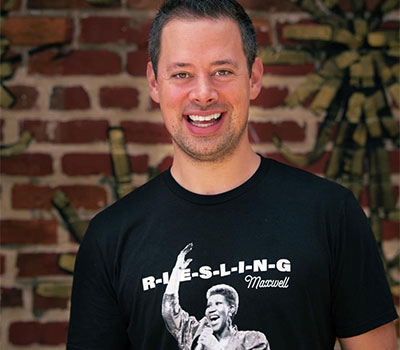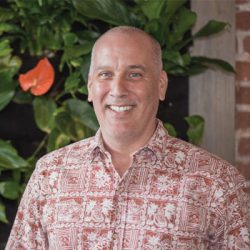

Last year, Brent Kroll had to cut almost his entire staff at Maxwell Park, a DC wine bar with two locations in Shaw and the Navy Yard. We talked with him about how the restaurant has bounced back, how he’s connecting wine-drinking generations with Northern Rhône syrah, and how his bar single-handedly changed DC’s Lambrusco landscape.
You went down from 22 people on your team to 6 last year. How have things changed from a year ago?
It even got as low as 3. [But] we’re probably up to about 80-90% of what our full staff level [which was 22]. Now we’re probably around 18. I’m still looking to hire more, and I’m working a job that I’m looking to replace myself in running one of the bars instead of overseeing things. I’ve been in that type of role since COVID started; instead of being where I can be extra hands, I’ve been wherever the most need has been. I’ve actually been the cook certain nights—and if you see me at the bar, I’m bussing tables instead of bartending.
I think I said this last year, but I posted something online where I was going through my P&Ls and looking at all the ways I could save money, then I posted it as kind of a help guide to everyone else and the ways they could actually save money. And I basically slashed the company down to nothing [but] where it could still function and pay rent through online events. And online events are down, but they’re still pretty big, I would say. They’re probably 5% of my revenue. We’re still selling wine to-go, which has been huge. I think that’s probably 5% of my revenue. So, I have 10% of my revenue that could have never existed before. Even though we started last year really, really rough, we now are doing significantly better [than last year]. Our worst year (2020) was probably our most impressive year because we just kept finding ways to make changes.
At one of our bars, we did frosé in the summer, which I swore I would never do in my entire life, and we thought about different types of marketing and promotion and stuff like that, and it was just… it wasn’t even “Do we need to pivot?” it was like, “What’s the next pivot?” When COVID started, I had two managers who had been with me for four years. There was no turnover. Now, my longest-tenured manager in the entire company has been with me seven months.
Going back to the events, it’s great to hear you’re still putting them on and receiving revenue from them. Has your approach to events changed over the year? What do you think makes them still attractive to consumers?
I think when we do events, we always try to make them fun. I don’t read off tech sheets from websites. Let’s say I made the topic about one region, and I talked about that region for two hours, it’s not as fun as when I do blind tasting workshops with people. I talk to them about how you perceive acid, tannin, body and structure in all beverages. I give them clues as they’re blind tasting. I tend to make jokes and analogies a lot. So, it’s broadened our platform and brought us some new people. The biggest one I did was for almost 600 people, for a national law firm.
I wouldn’t say we push it as hard now because we don’t have the luxury of expanding the bandwidth of staff. I wanted to start a wine club to expand our online or e-commerce presence, but I don’t think we have the bandwidth; I’m focusing on trying to make our in-house operations stronger. We still do classes when people reach out and ask, and we advertise for them on our website, but we’re not pushing them too much, because I think those are extensions of what we do as a bar. If the bar’s not strong, those things can’t be strong.
One of your top-selling wines was the Colombo Crozes-Hermitage. Why do you think that wine has been selling so much?
This probably goes back ten years in my career. People have this impression that cabernet sauvignon is soft in tannin and fruity because they enjoy Caymus or something; I’ve been getting a lot of these drinkers to expand their horizons and [telling them] “Hey, if you want soft tannins, if you want something that’s medium-plus in body, and you want something juicy but you’re ok with some earthy tones…” I think it pulls in the cab drinkers to syrah. What also happens is that you get these hipster wine drinkers that want a bunch of natty wines, and you’re just like, “Why don’t you try this funky northern Rhône syrah?” It’s bridging the gap between your old-school cabernet drinker and your natty-hipster-wine drinker.
You mentioned one of your biggest sellers was the Kir-Yianni Naoussa Ramnista Xinomavro, also the Sigalas Santorini Assyrtiko. Why do you emphasize Greek wines, and what’s the appeal with your customer base?
What I tell people for xinomavro is that you get these salted, Mediterranean olive tapenade/ tomato notes that you get from really good Bandol rouge—but you have the structure of nebbiolo. You can lay this stuff down and have ten-year-old xinomavro on a list that’s a hundred bucks and incredible. We were pouring the Kir-Yianni from 2015, and even that at seven years is zinging. As famous Barolos and Burgundies get less and less accessible, it’s easy to look to what’s being done in Northern Greece.
You were surprised by the amount of people buying sparkling red wine. Can you talk a bit about that?
When I moved to DC, there wasn’t much of a market for Lambrusco. Now, I can say there’s probably at least 40 different Lambruscos in DC. We do a week every year where we pour ten by the glass and pair them all with different types of charcuterie, in lieu of Restaurant Week. People hadn’t really wrapped their mind around liking dry Lambrusco or sparkling reds until the last few years, and I think now, if it hasn’t already arrived, I think it’s a golden era for those, where people seek them out. People get really excited about Lambrusco week. We typically go through a pallet of Lambrusco that week. I mean this to be more of a humble-brag, but we changed the amount of quality Lambruscos being brought into D.C by how much we started moving through the Lambruscos we have.
David lives in New York City and is always looking for the next wine story worth sharing.
This is a W&S web exclusive. Get access to all of our feature stories by signing up today.




















